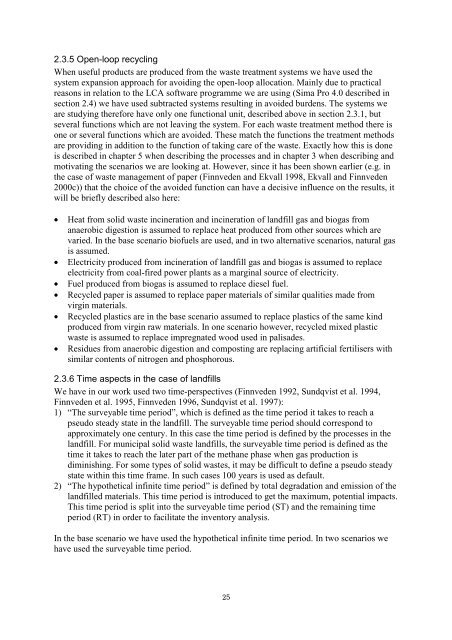Life Cycle Assessments of Energy From Solid Waste (PDF)
Life Cycle Assessments of Energy From Solid Waste (PDF)
Life Cycle Assessments of Energy From Solid Waste (PDF)
Create successful ePaper yourself
Turn your PDF publications into a flip-book with our unique Google optimized e-Paper software.
2.3.5 Open-loop recycling<br />
When useful products are produced from the waste treatment systems we have used the<br />
system expansion approach for avoiding the open-loop allocation. Mainly due to practical<br />
reasons in relation to the LCA s<strong>of</strong>tware programme we are using (Sima Pro 4.0 described in<br />
section 2.4) we have used subtracted systems resulting in avoided burdens. The systems we<br />
are studying therefore have only one functional unit, described above in section 2.3.1, but<br />
several functions which are not leaving the system. For each waste treatment method there is<br />
one or several functions which are avoided. These match the functions the treatment methods<br />
are providing in addition to the function <strong>of</strong> taking care <strong>of</strong> the waste. Exactly how this is done<br />
is described in chapter 5 when describing the processes and in chapter 3 when describing and<br />
motivating the scenarios we are looking at. However, since it has been shown earlier (e.g. in<br />
the case <strong>of</strong> waste management <strong>of</strong> paper (Finnveden and Ekvall 1998, Ekvall and Finnveden<br />
2000c)) that the choice <strong>of</strong> the avoided function can have a decisive influence on the results, it<br />
will be briefly described also here:<br />
• Heat from solid waste incineration and incineration <strong>of</strong> landfill gas and biogas from<br />
anaerobic digestion is assumed to replace heat produced from other sources which are<br />
varied. In the base scenario bi<strong>of</strong>uels are used, and in two alternative scenarios, natural gas<br />
is assumed.<br />
• Electricity produced from incineration <strong>of</strong> landfill gas and biogas is assumed to replace<br />
electricity from coal-fired power plants as a marginal source <strong>of</strong> electricity.<br />
• Fuel produced from biogas is assumed to replace diesel fuel.<br />
• Recycled paper is assumed to replace paper materials <strong>of</strong> similar qualities made from<br />
virgin materials.<br />
• Recycled plastics are in the base scenario assumed to replace plastics <strong>of</strong> the same kind<br />
produced from virgin raw materials. In one scenario however, recycled mixed plastic<br />
waste is assumed to replace impregnated wood used in palisades.<br />
• Residues from anaerobic digestion and composting are replacing artificial fertilisers with<br />
similar contents <strong>of</strong> nitrogen and phosphorous.<br />
2.3.6 Time aspects in the case <strong>of</strong> landfills<br />
We have in our work used two time-perspectives (Finnveden 1992, Sundqvist et al. 1994,<br />
Finnveden et al. 1995, Finnveden 1996, Sundqvist et al. 1997):<br />
1) “The surveyable time period”, which is defined as the time period it takes to reach a<br />
pseudo steady state in the landfill. The surveyable time period should correspond to<br />
approximately one century. In this case the time period is defined by the processes in the<br />
landfill. For municipal solid waste landfills, the surveyable time period is defined as the<br />
time it takes to reach the later part <strong>of</strong> the methane phase when gas production is<br />
diminishing. For some types <strong>of</strong> solid wastes, it may be difficult to define a pseudo steady<br />
state within this time frame. In such cases 100 years is used as default.<br />
2) “The hypothetical infinite time period” is defined by total degradation and emission <strong>of</strong> the<br />
landfilled materials. This time period is introduced to get the maximum, potential impacts.<br />
This time period is split into the surveyable time period (ST) and the remaining time<br />
period (RT) in order to facilitate the inventory analysis.<br />
In the base scenario we have used the hypothetical infinite time period. In two scenarios we<br />
have used the surveyable time period.<br />
25
















